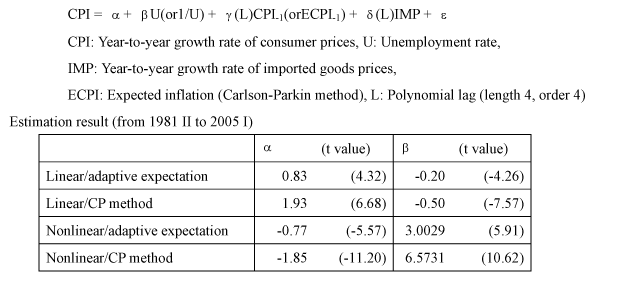Appended Note 1-1 Estimation Methods for Structural Unemployment Rate
- Japanese
- English
Appended Note 1-1 Estimation Methods for Structural Unemployment Rate
Unemployment is classified into several categories according to unemployment-inducing factors. Among them are 1) demand insufficient unemployment (unemployment caused by decrease in demand in recession period), 2) structural unemployment (unemployment caused by mismatches in vocational capability and age, etc. between the labor demand side and the supply side), and 3) frictional unemployment (unemployment caused by asymmetry of information between the labor demand side and the supply side, and time lag involved in workers' inter-regional movement).
Although it is difficult to strictly measure structural/frictional unemployment, the following two steps are taken in positive analyses: 1) UV analysis to measure equilibrium rate of unemployment, or the equilibrium point on the 45 degree line, based on the beverage curve of the unemployment rate and the vacancy rate and 2) estimation of NAIRU based on a Phillips curve.
Here, structural unemployment rate is estimated by using typical analytical methods.
1. UV analysis
(1) Estimation with structural changes specified
After studying the situation of structural changes in the same way as "FY2005 Analysis of Labor Economy," Ministry of Health, Labour and Welfare, the period from the first quarter of 1990 to fourth quarter of 1993 was identified as the period in which a stable shape can be obtained and then the unemployment rate was estimated by using generalized least square techniques, with the serial correlation of error terms taken into account.

Then, by using the estimation result and assuming the unemployment rate where U corresponds with V as the equilibrium rate of unemployment U*, the following formula was worked out.

(2) Estimation with structural changes incorporated
Structural changes of UV curve were incorporated as explaining variables and then the following formula was worked out by using least square techniques.

Assuming that equilibrium rate of unemployment is U*, equilibrium number of unemployed people is X, and the number of employees is Y,

Consequently, the equilibrium rate of unemployment U** is U** = X / (X + Z) x 100, with Z being the number of persons engaged.

2. Measurement of NAIRU
(1) Measurement of fixed NAIRU
Fixed NAIRU is a measuring method that assumes no change in the value during the observation period. It formulates linear and nonlinear types from expectation adjustment Phillips curves based on Mankiw (2002) and estimation is made with least square techniques by using adaptive expectation or expected inflation rate based on Carlson-Parkin method

(2) Measurement of variable NAIRU
Variable NAIRU is a measuring method that allows changes in the value during the observation period. It works out the following formula in maximum-likelihood method by using a state space model (Kalman filter).

